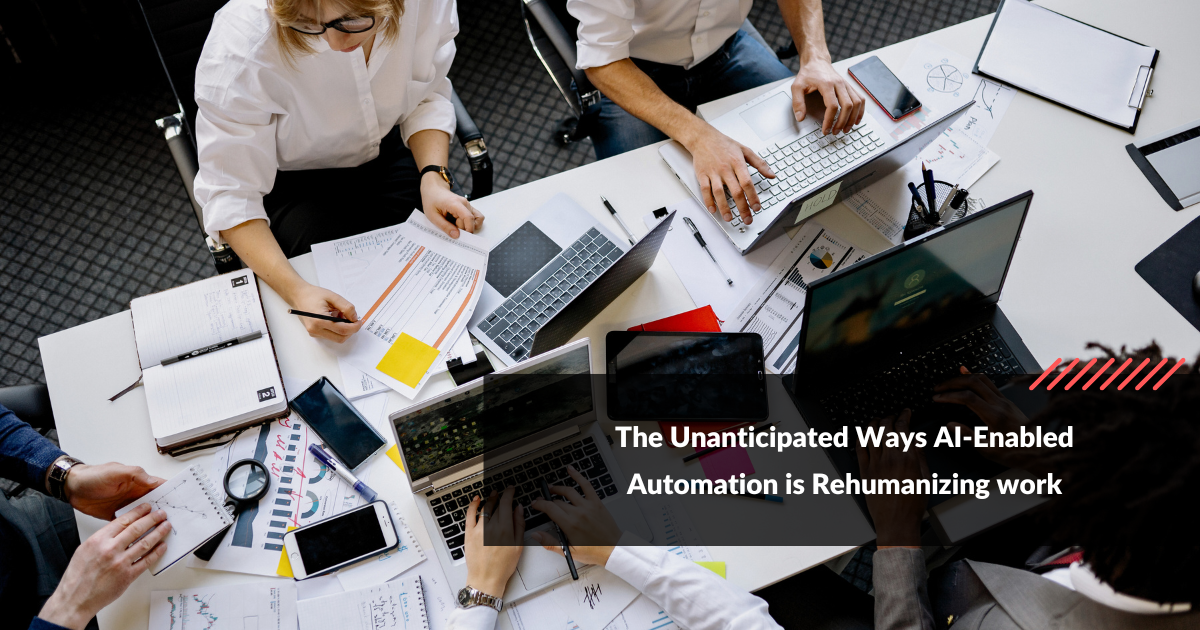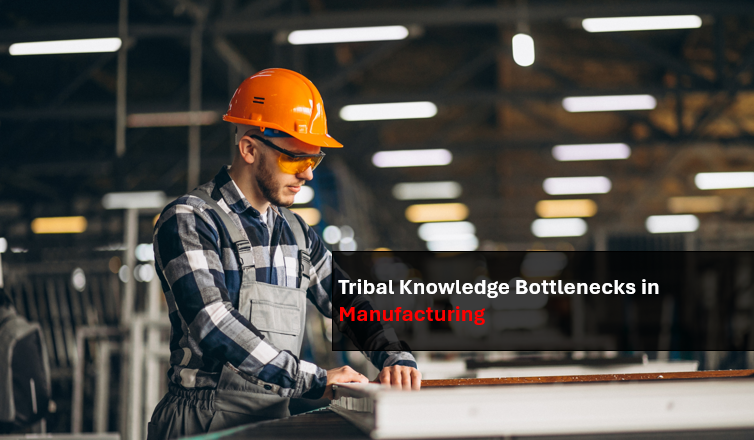In the realm of automation, a remarkable shift has occurred with the advent of AI. Unlike traditional automation, which was limited to rule-based processes and structured data, the integration of AI in automation solutions has opened a world of possibilities for organizations. They can now streamline complex processes and enhance overall efficiency, all while fostering a work environment that values employee well-being and growth.
In this blog, we will delve into this remarkable paradigm shift: the unexpected ways in which AI-enabled automation is not only revolutionizing work processes but also rehumanizing the workplace experience. Far from diminishing the value of human effort, AI is serving as a catalyst for unlocking human potential and igniting a renewed sense of purpose in the modern workplace.

Empowering Human Creativity:
A. The Rise of AI in Handling Repetitive Tasks:
The advent of AI-enabled automation has ushered in a new era of efficiency by taking on repetitive and mundane tasks. From data entry to sorting and processing vast amounts of information, AI-driven systems can handle these tasks with unparalleled speed and accuracy. As a result, human employees are liberated from the shackles of repetitive chores that were once time-consuming and mentally taxing.
B. Unleashing the Potential for Creativity and Innovation:
With the burden of repetitive tasks lifted, employees have newfound time and mental space to focus on more creative and strategic endeavors. This transformative shift empowers human workers to fully harness their creativity and intellectual capabilities. Instead of being confined to rote tasks, they are now empowered to think critically, brainstorm innovative ideas, and explore uncharted territories that drive business growth and advancement.
The synergy between AI-driven automation and human ingenuity is paving the way for a rehumanized workplace that celebrates the art of creativity and empowers us to achieve new heights of success.
Augmenting Human Intelligence
A. The Rise of AI as a Cognitive Partner:
In the era of AI-enabled automation, machines are no longer simply tools but are emerging as cognitive partners that augment human intelligence. AI’s capacity to process and analyze colossal volumes of data at lightning speed equips it with the ability to complement human thinking. This collaborative partnership between humans and AI transforms how we approach complex problem-solving and decision-making.
B. Human-AI Collaboration in Decision-Making:
As AI becomes an integral part of decision-making processes, it acts as a supportive and unbiased ally to human leaders. Integrating AI-enabled automation, processing of data, and other manual tasks at such an unprecedented speed enables the business leader to now have time to analyze those data. This collaboration with AI empowers them to make informed choices based on a wealth of data, minimizing the risks associated with gut-based decisions unlike before and ensuring a higher likelihood of success.
One of the most significant advantages of AI in decision-making is its ability to analyze vast amounts of data swiftly and accurately. AI excels in this area, revealing patterns, trends, and connections that might otherwise remain concealed. Armed with these valuable insights, human decision-makers can devise more effective strategies and capitalize on emerging opportunities.
This collaboration between humans and AI fosters a work environment that celebrates the diversity of thought, allowing humans to focus on tasks that require empathy, emotional intelligence, and nuanced understanding while AI handles data-driven analysis. Combining human intuition and AI-driven insights leads to more robust decision-making, propelling organizations toward growth and innovation.
Enhancing Employee Well-being

A) A New Era of Employee Well-being:
In the unanticipated ways AI-enabled automation is revolutionizing work, employee well-being takes center stage. Traditionally, automation may have been associated with concerns about job displacement and impersonal work environments. However, the reality is far from this apprehension. AI is redefining the workplace by fostering a more balanced and fulfilling work-life for employees.
B) Reducing Repetitive Tasks and Work-Related Stress:
One of the profound impacts of AI in the workplace is its ability to take on mundane and repetitive tasks. By automating these routine responsibilities, AI empowers employees to focus on more meaningful and intellectually stimulating work. Liberated from the burden of monotonous tasks, employees experience reduced work-related stress and increased job satisfaction.
AI-enabled automation is not about replacing human effort but elevating it. For instance, when it comes to invoice processing, the manual entry of all the details is very time-consuming. The invoices can be conveniently processed when the process is automated. This enhances customer experiences and contributes to employee well-being by aligning their roles with their inherent capabilities.
This human-centric shift isn’t just limited to individual workflows—it’s reshaping entire industries. For instance, in manufacturing, AI is dissolving silos to create seamless, efficient workflows, proving that automation and collaboration can coexist harmoniously. Learn more about this transformation in how AI is transforming manufacturing workflows.
C) Embracing Flexible Work Arrangements:
The integration of AI has facilitated the adoption of flexible work arrangements. AI-powered technologies enable seamless collaboration and communication across various locations, promoting remote work opportunities. Employees can now enjoy greater autonomy in managing their schedules, leading to improved work-life balance and increased job fulfillment.
By embracing AI-enabled automation, organizations create a supportive and empathetic work environment. The collaboration between humans and AI amplifies employee potential, creating a sense of fulfillment in contributing meaningfully to the organization’s success.
Fostering Human-Machine Collaboration
A) The Dynamic Nature of Human-Machine Collaboration:
The symbiotic relationship between humans and AI is at the heart of the dehumanization of work. The workplace is evolving into a harmonious space where human creativity and emotional intelligence merge seamlessly with AI’s analytical prowess. Gone are the days of viewing AI as a mere tool; it has emerged as a cognitive partner, enhancing human capabilities and enabling us to achieve feats that were once considered beyond our reach.
B) Trust and Transparency in Human-AI Partnerships:
For human-machine collaboration to thrive, trust and transparency become pivotal. Employees must have confidence in the AI-enabled automation platforms they work with and understand their functions and limitations. Organizations foster an environment where employees feel empowered and included by being transparent about the decision-making processes involving AI.
C) Some Successful Collaboration:
The impact of successful human-AI-enabled automation collaboration is visible across diverse sectors. Let’s take the case of a major credit union operating across two states in the US. Working with a vast network of loan originators, this financial institution faced significant challenges in its manual mortgage processing system. The process involved laborious validation of multiple documents, resulting in delays, backlogs, and errors.
By leveraging RAP’s AI-powered automation, the credit union automated document processing, reducing handling time by a staggering 97%. This swift and accurate automation streamlined the mortgage processing workflow, allowing the credit union to process loans efficiently and promptly respond to customer needs.
Another compelling case that exemplifies the impact of successful human-AI-enabled automation collaboration is that of a distinguished US-based automobile dealer. Faced with a sluggish manual quote processing system; the dealership was grappling with prolonged response times and dwindling customer satisfaction. Prospective customers had to wait days to receive a quote, resulting in a decline in sales rates.
Seeking a rapid solution to enhance customer experience and boost sales winnability, the dealership turned to AI-enabled automation. The results were transformative. The average quote response time was reduced to under 30 minutes. The implementation also brought about an impressive 300% return on investment (ROI), primarily driven by substantial time savings.
Conclusion
Throughout this exploration, we have witnessed the transformative power of AI-enabled automation in rehumanizing work. What was once perceived as a threat to human jobs has evolved into an enabler of human potential. AI takes on repetitive tasks, freeing time for employees to focus on creativity, critical thinking, and collaboration. This shift has fundamentally changed how we approach work, creating a more dynamic and fulfilling environment.
As businesses redefine human-centric roles, it’s also critical to bolster backend operations. Learn how automation helps teams win more chargebacks by building stronger cases through data-driven processes — read more here.
We stand at the threshold of a new era where AI and human ingenuity work hand in hand to reshape the future of work. Businesses can unlock new opportunities and drive innovation by recognizing the unanticipated ways AI-enabled automation enhances the human experience.
Remember, the true potential of AI lies in the possibilities it creates for humanity. As AI-empowered leaders, let us build a future where work is not just a means to an end but a platform for human creativity, collaboration, and well-being. Together, we can forge a path toward a reimagined work landscape that celebrates the very essence of what it means to be human.
If you’re eager to explore more about AI-empowered work environments and their potential for your organization, contact us today! Let’s take the first step towards a future where humans and AI thrive in harmonious collaboration.




